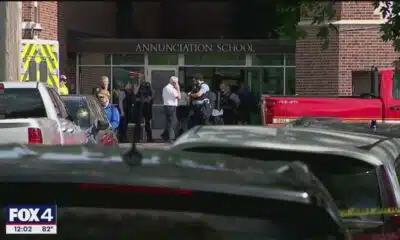News from the South - Arkansas News Feed
Report: April storms that caused “generational” flooding made 40% more likely by climate change
by Ainsley Platt, Arkansas Advocate
May 9, 2025
“Generational” April storms that brought historic rainfall and a record number of tornadoes to states in the Central Mississippi river valley like Arkansas were made 40% more likely due to the warming climate, according to a new report from an international coalition of climate researchers.
The analysis, published Thursday by World Weather Attribution, which is housed under Imperial College London, says the rainfall was “the worst ever recorded in this region,” with economic damages estimated between $80 and $90 million across the affected states. The vast majority occurred in Arkansas, which had roughly $78 million in agricultural damages.
Researchers, who analyzed weather data and climate models for the study, told reporters during a briefing Tuesday that it would cost Arkansas farmers $42 million to replant.
Meanwhile, the University of Arkansas System, which was not part of the study, came to similar conclusions. Ryan McGeeney, a communications specialist for the University of Arkansas System’s Division of Agriculture, said they estimated there were roughly $79 million in agricultural damages, mainly as a result of flooding.
The timing of the flooding mitigated the impact, McGeeney said. Winter wheat crops in the affected areas were a total loss, he said, while corn also suffered damage but could be replanted. The soybean crop was rebounding, but the jury was still out on whether the rice crop would be affected, he added.
In the grand scheme of things, McGeeney said, $79 million is a drop in the bucket compared to the economic impact of agriculture as a whole in Arkansas — $24.3 billion.
Bernadette Woods Placky, the chief meteorologist for Climate Central, which participated in the research, credited the National Weather Service for accurate and early warnings that likely saved numerous lives.
“Staff in local National Weather Service offices worked around the clock to provide life-saving information and services,” Woods Placky wrote. “This is an example of how critical these employees are and why recent workforce cuts risk undermining their ability to keep people safe.”
Multiple experts have raised alarms in recent months about proposals to cut funding to the National Oceanic and Atmospheric Administration — of which the NWS is a part — fearing that cuts to NOAA will hamstring the weather office’s ability to make accurate forecasts.
Many local NWS offices are already understaffed, and a hiring freeze that has been in place since the start of the second Trump administration has left the service unable to hire the specialized technicians needed to repair its radar systems or to fill open forecasting positions.
According to the analysis, the similar extreme rainfall events are “relatively rare, expected to occur in today’s climate only once every 90-240 years.” However, in a cooler climate, the analysis found, “extreme rainfall such as observed would be even rarer.”
“Fossil fuel warming is clearly driving more intense, and increasingly costly, extreme weather across the US,” said Ben Clarke of the Centre for Environmental Policy at Imperial College London.
Storm formation
The April storm event was significant for a number of reasons, said Shel Winkley, a meteorologist and a weather and climate engagement specialist for Climate Central. Not only was it one of the most intense spring rain events ever recorded for the region; by the end of the day on April 2, the NWS had issued 728 severe thunderstorm and tornado warnings — the third-most ever.
The region saw “relentless” rounds of storms April 3-6, dumping more than a foot of rain on some areas, Winkley said. These persistent storms were part of what is called a mesoscale convective system — a massive storm that is larger than an individual thunderstorm, but smaller than an extratropical cyclone.
While storms in Arkansas and the southeast tend to move west to east, a persistent “ridge” of near-record-high pressure settled east of Arkansas and the other affected states. According to Winkley, this high pressure area forced a low pressure system (thunderstorms, like tropical storms, are often associated with low pressure systems) to stall over Arkansas and the other states instead of continuing to move eastward.
The high pressure ridge caused warm, moist air from the Gulf of Mexico to be drawn into the lower levels of the storm, providing most of the fuel needed for the storms to continue to dump torrential rainfall for days, the analysis found.
The area where the high pressure and low pressure met — the “stalled front” — became the pathway that the rounds of storms travelled along, continually dumping rain on the same area for days because the front was stuck in place, he said.
Meanwhile, researchers said that while the states impacted by the rainfall event were not coastal states, the storm itself was helped along by historically warm waters in the Gulf of Mexico, which increased the amount of moisture in the atmosphere and drove the storms.
According to Climate Central, the average temperature in Arkansas last month was 5 degrees Fahrenheit warmer, compared to its 30-year average. Rainfall, comparatively, was nearly 250% higher than average for the month.
Warmer temperatures and Gulf waters are contributing to more convective available potential energy (CAPE) days where there is sufficient instability and moisture in the atmosphere to spawn severe weather conditions, Winkley said. Northeast Arkansas, where the worst flooding occurred last month, in particular is seeing this trend, he said.
An increase in CAPE days doesn’t necessarily mean there would be an increase in severe thunderstorms or tornadoes, just that the potential for those storms to form was occurring more frequently.
He did, however, say that when storms did form, they tended to be much more severe.
Arkansas has been hammered by severe weather in recent years. Numerous tornadoes devastated communities in 2023, 2024 and 2025, including in Little Rock, while severe river and flash flooding has occurred on multiple occasions in the last 12 months. June 2023 saw weeks of persistent severe weather, with damaging straight-line winds and hailstorms that dropped hailstones as large as four inches.
While some federal assistance to respond to last month’s flooding was approved, Gov. Sarah Huckabee Sanders is appealing the Trump administration’s denial of assistance for those affected by an earlier round of storms in March. That line of storms spawned multiple violent tornadoes that tore through Cave City and other, smaller towns in the region.
The denial of federal aid comes as the Trump administration debates eliminating FEMA, which has disbursed billions of federal aid in the wake of natural disasters to affected communities. Meanwhile, the administration announced Thursday that it would stop tracking the costs of the most expensive natural disasters.
GET THE MORNING HEADLINES.
Arkansas Advocate is part of States Newsroom, a nonprofit news network supported by grants and a coalition of donors as a 501c(3) public charity. Arkansas Advocate maintains editorial independence. Contact Editor Sonny Albarado for questions: info@arkansasadvocate.com.
The post Report: April storms that caused “generational” flooding made 40% more likely by climate change appeared first on arkansasadvocate.com
Note: The following A.I. based commentary is not part of the original article, reproduced above, but is offered in the hopes that it will promote greater media literacy and critical thinking, by making any potential bias more visible to the reader –Staff Editor.
Political Bias Rating: Center-Left
The article primarily presents a factual analysis of the link between climate change and the increased likelihood of severe weather events, specifically focusing on April’s storms in Arkansas. While it discusses the scientific findings of an international climate research team, it includes subtle commentary on the impacts of climate change, with quotes from climate experts like Ben Clarke. The article also touches on the potential political ramifications of weather-related federal aid, highlighting concerns about staffing cuts within the National Weather Service and proposed reductions to NOAA, which aligns with a critique of the Trump administration’s policies. This nuanced tone, with attention to the political aspects of environmental and disaster response, leans slightly toward a Center-Left perspective but does not overtly advocate for one political side. The factual reporting on climate science and weather events is clear and balanced.
News from the South - Arkansas News Feed
‘This is what we all work for’: Longest term foster child in Arkansas adopted
by Ainsley Platt, Arkansas Advocate
August 25, 2025
Even the judge was smiling by the end of Cozy Dietrich’s adoption hearing.
Cozy had been in foster care longer than any other person in Arkansas’ foster system — until Monday morning, when Anna and Tim Dietrich of Little Rock adopted the nonverbal 19-year-old. He took his new family’s last name.
An atmosphere of joy dominated the small Pulaski County Circuit Court hearing room where his adoption was finalized. When Circuit Judge Tjuana Byrd Manning brought the hearing to a close, the celebration started. The lights dimmed, and court staff — Manning included — pulled out flashing, multi-colored lights as Justin Timberlake’s “Don’t Stop the Feeling” played over the courtroom’s speakers and the standing-room-only audience clapped and cheered.
For many, the celebration was warranted. Cozy entered foster care in October 2010, and has been available for adoption since October 2011, according to a Department of Human Services spokesperson. In all, Cozy spent nearly 15 years in Arkansas’ foster system.
Anna Dietrich said she and her husband had always been open to adopting, but had been waiting for the right person. Anna Dietrich has long worked within the state’s foster system as a logistics coordinator for Project Zero, an Arkansas nonprofit dedicated to placing every child in a loving, permanent home.
Cozy’s disabilities meant having a family “with understanding, patience, and love would be instrumental in supporting” him, according to his Project Zero Heart Gallery page. The Heart Gallery has profiles of adoptable children in Arkansas to help match them with adoptive families.
“To say yes to one was to say no to others,” Anna Dietrich said. “The Lord was going to have to make it clear who was ours. He’s just made it abundantly clear.”
Cozy is their first child.
The Dietrichs were clearly thrilled about the adoption. Anna could be seen beaming at her new son as he ate peanut butter crackers and communicated via hand signals with a companion in the front row of the small gallery before the adoption hearing started.
GET THE MORNING HEADLINES.
Newly-confirmed Department of Human Services Secretary Janet Mann also attended and choked up after the hearing when congratulating the Dietrich family.
“This is what we all work for,” she said. “This is the inspirational example of how every child deserves a family.”
Not every foster child goes up for adoption. According to Tiffany Wright, the director of DHS’ Division of Child and Family Services, the vast majority that enter the foster system return to their families, but roughly 200 are currently waiting for adoptive families.
In fiscal year 2023, the most recent year with available data, over 36,000 children nationwide remained in foster care despite being available for adoption, according to the National Council for Adoption. Of the more than 184,000 children who exited the nation’s foster care systems that year, 27% were adopted.
“Youth who enter care often endure trauma or have medical conditions that make finding a family hard, but we will never give up. We work to identify an appropriate family that can provide for a child in the long term. That’s what happened in today’s case,” Wright said.
Cozy’s adoption was also significant due to who his adoptive parents were.
“Anna has championed and featured children in the Heart Gallery, and works hard to find adoptive families for them,” Wright said. “There are countless children living happy lives with adoptive families across our state because of the work of Anna and Project Zero.”
Adopting a child isn’t as straightforward as filling out a form, Wright said. It’s a long process that involves home inspections, information sharing with interested families and transitional visits. Even when a suitable family is identified, adoptees also have to have lived with them for a certain period of time before the adoption can be finalized.
“You have to be in an adoptive home for six months, that’s typically the trigger that you can finalize the adoption,” Wright said.
YOU MAKE OUR WORK POSSIBLE.
Arkansas Advocate is part of States Newsroom, a nonprofit news network supported by grants and a coalition of donors as a 501c(3) public charity. Arkansas Advocate maintains editorial independence. Contact Editor Sonny Albarado for questions: info@arkansasadvocate.com.
The post ‘This is what we all work for’: Longest term foster child in Arkansas adopted appeared first on arkansasadvocate.com
Note: The following A.I. based commentary is not part of the original article, reproduced above, but is offered in the hopes that it will promote greater media literacy and critical thinking, by making any potential bias more visible to the reader –Staff Editor.
Political Bias Rating: Centrist
This content presents a straightforward, human-interest story focused on the adoption of a foster child and the efforts of individuals and organizations involved in the foster care system. It avoids partisan language or political framing, emphasizing compassion, community support, and the functioning of social services. The tone is positive and factual, appealing broadly without aligning with a particular political ideology.
News from the South - Arkansas News Feed
Health insurance will cost more for millions of Americans — especially rural residents
by Shalina Chatlani, Stateline, Arkansas Advocate
August 22, 2025
A combination of Trump administration policies will make health care coverage more expensive for people who purchase plans from health insurance marketplaces — and rural residents will be hit the hardest, according to a new analysis.
Researchers from the Century Foundation say Trump administration policies — especially its refusal to ask Congress to extend Biden-era tax credits that are set to expire at the end of this year — will boost out-of-pocket premiums by 93% in the 32 states that allow the federal government to operate their Affordable Care Act insurance marketplaces. New rules and tariffs will have a smaller impact.
Rural county residents in those states will see an increase of 107%, while residents of urban counties will pay 89% more, according to the analysis by the Century Foundation, a left-leaning research nonprofit.
Insurers participating in the Affordable Care Act marketplaces are proposing a median premium increase of 18% for 2026 — the biggest jump since 2018 and 11 points more than the growth from 2024 to this year. That bump would come on top of the increase resulting from the expiration of the tax credits and the other policy changes.
About 2.8 million people who are enrolled in marketplace plans in the 32 states live in rural counties, including 776,000 adults between the ages of 55 to 64 and more than 223,000 children, according to the Century Foundation.
“Rural residents tend to be older. They may be more likely to have chronic illness at the same time,” said Jeanne Lambrew, director of health care reform at the foundation. “It costs more, both because they have somewhat greater needs and less access to health care.”
The researchers calculated that average annual premiums for rural residents will increase by $760 — 28% more than the expected average increase for urban residents. States where rural enrollees are expected to see the highest cost increases are Wyoming ($1,943), Alaska ($1,835), and Illinois ($1,700).
Many of the states with a large number of rural residents have chosen not to expand Medicaid under the Affordable Care Act, meaning many people who earn between 100% and 138% of the federal poverty level, between $15,650 and $21,597 for an individual, get their coverage from an insurance marketplace, Lambrew said.
Of the seven states where 10% or more of rural residents are enrolled in marketplace plans (Alabama, Mississippi, Nebraska, North Carolina, South Carolina, Texas and Wyoming), only two — Nebraska and North Carolina — have expanded Medicaid.
State officials in Pennsylvania recently advised residents who use the marketplace that they should closely examine the plans that are available.
“This year, even more than previous years, Pennsylvanians should consider shopping around to find the best plans to meet their individual needs, at a price that makes sense for their current financial situation,” Pennsylvania Insurance Commissioner Michael Humphreys said in a statement released at the beginning of this month.
Lambrew said the increases will force many people to forgo insurance altogether.
“It’s harmful for those individuals in terms of their own health and life expectancy. It’s harmful for our providers, because they’re now dealing with people who are sicker and in the wrong settings, and it’s kind of expensive for our society,” Lambrew said.
“We know health insurance matters, so having these large potential increases on uninsured Americans is distressing.”
Stateline is part of States Newsroom, a nonprofit news network supported by grants and a coalition of donors as a 501c(3) public charity. Stateline maintains editorial independence. Contact Editor Scott S. Greenberger for questions: info@stateline.org.
Arkansas Advocate is part of States Newsroom, a nonprofit news network supported by grants and a coalition of donors as a 501c(3) public charity. Arkansas Advocate maintains editorial independence. Contact Editor Sonny Albarado for questions: info@arkansasadvocate.com.
The post Health insurance will cost more for millions of Americans — especially rural residents appeared first on arkansasadvocate.com
Note: The following A.I. based commentary is not part of the original article, reproduced above, but is offered in the hopes that it will promote greater media literacy and critical thinking, by making any potential bias more visible to the reader –Staff Editor.
Political Bias Rating: Center-Left
The content presents a critical view of Trump administration policies and highlights the negative impact on healthcare affordability, particularly for rural residents. It references analysis from the Century Foundation, a left-leaning think tank, and emphasizes concerns about the expiration of Biden-era tax credits and Medicaid expansion. While it focuses on policy effects without overt partisan language, the framing and sources suggest a center-left perspective that supports expanded healthcare access and government intervention to mitigate premium increases.
News from the South - Arkansas News Feed
New I-55 bridge between Arkansas, Tennessee named after region’s three ‘Kings’
by Sonny Albarado, Arkansas Advocate
August 21, 2025
A long-planned new Interstate 55 bridge connecting Arkansas and Tennessee will be known as Kings’ Crossing, officials from the two states announced this week.
The new name “honors three transformative figures known as ‘Kings’” — civil rights martyr Dr. Martin Luther King Jr., bluesman B.B. King and rock’n’roll star Elvis Presley, according to a press release from the Arkansas Department of Transportation. The project had been named “America’s River Crossing,” according to previous news releases. The Arkansas Highway Commission and Tennessee General Assembly officially adopted the new moniker.
The bridge will replace the existing 75-year-old Memphis-Arkansas Bridge that carries I-55 traffic between West Memphis and Memphis. The new bridge is being funded by $400 million from the federal Rebuilding American Infrastructure with Sustainability and Equity (RAISE) program and $200 million each from Arkansas and Tennessee, making it the single largest transportation investment in both states, according to the press release.
The narrow existing bridge will be replaced with a larger structure designed to meet modern seismic codes, as it sits on the New Madrid fault line, officials said.
“It’s only fitting to name this vital crossing after three historic figures from this region,” said ARDOT Director Jared Wiley. “It truly is the result of a regional effort that will benefit industry across this national corridor and the thousands of individuals who depend on this connection each day.”
Tennessee Department of Transportation Commissioner Will Reid said Kings’ Crossing is a “symbol of our collective history, heritage, and the enduring spirit of unity that defines this region. Naming this bridge in honor of these gentlemen pays tribute to their extraordinary legacies — individuals who transcended barriers, fostered cultural exchange, and used their talents to build bridges between people.”
The Federal Highway Administration has approved a draft environmental assessment for the project, and public hearings will be held in November, according to TDOT’s website.
Design is underway, and right-of-way coordination should begin later this year, according to ARDOT’s press release. Construction is estimated to start in fiscal year 2026.
For more information about the proposed project, visit TDOT’s website.
Arkansas Advocate is part of States Newsroom, a nonprofit news network supported by grants and a coalition of donors as a 501c(3) public charity. Arkansas Advocate maintains editorial independence. Contact Editor Sonny Albarado for questions: info@arkansasadvocate.com.
The post New I-55 bridge between Arkansas, Tennessee named after region’s three ‘Kings’ appeared first on arkansasadvocate.com
Note: The following A.I. based commentary is not part of the original article, reproduced above, but is offered in the hopes that it will promote greater media literacy and critical thinking, by making any potential bias more visible to the reader –Staff Editor.
Political Bias Rating: Centrist
The content presents a straightforward news report about the naming and construction of a new Interstate 55 bridge, highlighting bipartisan cooperation and honoring widely respected historical and cultural figures. It focuses on infrastructure development and regional collaboration without promoting a particular political ideology or agenda, reflecting a neutral and balanced perspective.
-
News from the South - Arkansas News Feed6 days ago
New I-55 bridge between Arkansas, Tennessee named after region’s three ‘Kings’
-
News from the South - Texas News Feed4 days ago
DEA agents uncover 'torture chamber,' buried drugs and bones at Kentucky home
-
News from the South - Louisiana News Feed7 days ago
Families with citizen children deported by ICE sue Trump administration
-
News from the South - Georgia News Feed7 days ago
Bookman: Here’s how Georgia’s 2020 election crisis will factor into 2026 GOP campaigns for governor
-
News from the South - Missouri News Feed6 days ago
Missouri settles lawsuit over prison isolation policies for people with HIV
-
News from the South - Virginia News Feed6 days ago
Erin: Tropical storm force winds 600 miles wide eases into Atlantic | North Carolina
-
Our Mississippi Home6 days ago
Vardaman: The Sweet Potato Capital Serving Up Love, Tradition, and Flavor at Sweet Potato Sweets
-
Local News5 days ago
Florida must stop expanding ‘Alligator Alcatraz’ immigration center, judge says










































